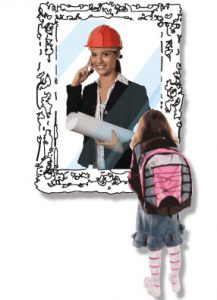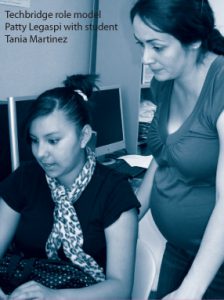Opening Minds, Raising Sights
Mentored by technical professionals, girls explore routes to upward mobility.
One sunny Friday afternoon, Google engineering manager Patty Legaspi stood before a classroom of girls at Oakland Unity High School and told them the story of her life. Born in Berkeley, Calif., to Mexican immigrants, she and her siblings grew up not far from where the girls sat that day. “Thirty-sixth and East 14th? You know where that is?” Legaspi asked. Heads nodded. Legaspi told the girls that she graduated from high school in 1999 with a 4.0 GPA, but her parents didn’t want her to leave home for college because it would take her away from her family. It was a situation many of the girls might find familiar. But Legaspi’s very presence in the classroom offered proof that such obstacles could be overcome.
Legaspi volunteers as a role model for Techbridge, an after-school program run by the Chabot Space & Science Center in Oakland that aims to get girls in underrepresented groups excited about engineering. All women in technical fields, role models engage in hands-on projects with the students, give them tours of their workplaces, or simply visit their schools and talk, as Legaspi did. Begun in 2000, Techbridge operates in 18 middle and high schools in the San Francisco Bay Area and serves about 400 girls each year. Some 2,500 students have gone through the program.
Many of the girls may not know an engineer, let alone have a family member in the profession, says Linda Kekelis, Techbridge’s project director. Asking them what they want to be elicits responses such as “a cashier” or “to do hair and nails,” Kekelis says. The role models, who often share backgrounds similar to the girls’, help to forge a personal connection and introduce engineering as a potential career.
As in Legaspi’s case, cultural pressures can discourage some girls from pursuing a college degree. Latinos place a lot of importance on keeping their families together, she explains, so parents don’t like the idea of daughters leaving home for school. “Many immigrant parents don’t get that college is a must-have,” Legaspi says.
With the help of counselors at her Catholic high school, Legaspi put college applications together and found a way to address her family’s concerns. By enrolling at Holy Names College (now University) in Oakland, she was able to attend a school close to home. Later, she transferred to Mills College, still in Oakland. A Gates Millennium Scholarship helped cover the cost. Legaspi excelled academically and landed a coveted job at Google after graduating in 2002.
Sharing a personal story is an effective way to make a connection with kids, Kekelis says. But that might not occur to an engineer who deals with adults most of the time. When one role model tried to give an hourlong PowerPoint presentation to a group of Techbridge students, the girls’ “eyes glazed over,” Kekelis recounts. “Most role models don’t know how to be a role model.”
Training and Useful Tips
Now, Techbridge offers training workshops each fall, giving role models tips on how best to relate to girls. The organization also provides a toolkit on CD-ROM containing suggestions for fun icebreaker activities, lists of questions role models can ask students, sample agendas for classroom visits, and links to additional engineering resources for girls. Techbridge has a roster of hundreds of role models, so it can match the right person with a particular project, says program coordinator Martha Peña. Even role models who have been working with Techbridge for several years will get regular calls from the staff to discuss their needs. “That’s why we have good retention of role models,” Peña says.
Josetta Jones, a Techbridge role model for about five years, benefited firsthand from exposure to older professionals. While a chemical engineering major in college, she got the chance to hear a talk on patent law arranged by the National Society of Black Engineers. It intrigued her, and she eventually decided to go to law school after getting her engineering degree. Now she is herself a patent attorney with Chevron. “It just takes somebody to let you know what opportunities are available and to be thinking about it early enough,” Jones says. “I want the girls to understand that you might want to do something else besides be a scientist, but you can still be in a technical field and have a great impact with it.”
During classroom visits, Jones has helped girls make rubber balls and tie-dyed T-shirts in order to talk about the chemistry involved. Legaspi’s job at Google involves managing engineers who test software, so she led the girls at Oakland Unity through an exploration of Google Earth, the global geographical mapping application. The girls used the software to search for the places that mattered to them – their homes in Oakland, the cities their families came from in Mexico and Central America, and fun spots like Disneyland.
Juliana Velez, a former Techbridge student who is now a junior at MIT majoring in mechanical engineering, got interested in green buildings after meeting role models from Swinerton, a construction engineering firm. “I’d always been interested in the environment and recycling, but I didn’t really know what green buildings were,” Velez says. “I found the role models who came in very engaging and very interesting.” She interned at Swinerton last summer and plans to continue studying green building design in graduate school.
Tours of role models’ workplaces are coordinated with the hands-on projects the girls work on throughout the school year. If the girls do a project with circuits, like rewiring an “Operation” game board, they might visit a company like Intel. A project to build a green dollhouse might merit a visit to a construction site.
The workplace tours take some creative planning to make them most effective. “A lot of companies have a standard tour they give to adults,” Peña says, “but children will be falling asleep or texting their friends in the back.” So when a group of Techbridge girls toured Yahoo, the planners decided to make it a scavenger hunt. The search required the girls to ask questions of the engineers who work there.
Each after-school session starts with an icebreaker activity to get everyone talking, and that can be a good opportunity to learn what the girls are interested in. One time, for example, Jones simply asked whether the girls preferred the singer Beyoncé or Rihanna. “Part of that is so we can have an open discussion so that what I say has some truth and validity to them,” Jones says. “To gain their trust is very important.”
Jones also takes cues from the teachers who supervise the Techbridge program at their schools. “The teachers really let the role models run the class for the afternoon, but I do watch how the teachers interact with the girls,” Jones says. The teachers “let the girls know that we can work at this together and that we can have a friendly relationship.”
Techbridge encourages the role models to speak candidly about their experiences, which can include stories about how tough it can be to pursue an engineering career. Legaspi told her class about eight grueling hours of interviews she endured to get the job at Google. She left in tears but got the job.
At the end of her recent visit, the girls were sufficiently comfortable to inquire about her pregnancy and her husband and family, as well as her job. “I love challenges,” Legaspi told them. “Every day I learn something new.”
Corinna Wu, a freelance writer based in Oakland, Calif., was managing editor of the recently published eGFI – Engineering, Go For It (www.egfi-k12.org).
Category: Teaching

